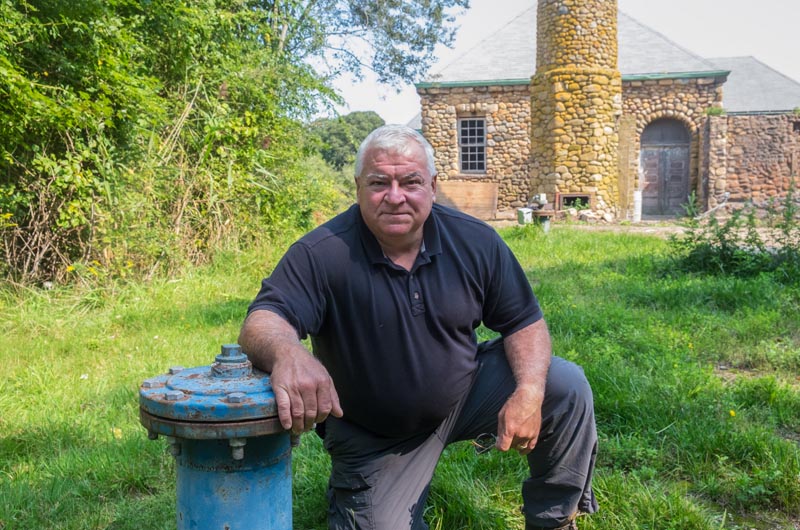A steady increase in water use in Oak Bluffs abated somewhat this year, but town officials are bracing for a time when the five municipal wells in town can no longer satisfy the summer demand.
“We don’t really have a good cushion to be able to supply water for fire protection,” Oak Bluffs water district superintendent Kevin Johnson said in a recent interview. “If we lose a well, there is a point when we will be definitely challenged to provide water.”
The district saw about a 35 per cent increase in summer water pumping between 2013 and 2016, with a peak of 73.8 million gallons last August. The numbers dropped significantly this summer, with a peak of about 60.7 million gallons in August.
The district operates as an independent governmental entity, with five wells, including three in the state forest, one on Tradewinds Road, and one on Barnes Road. At full capacity, the wells can provide about five million gallons per day, Mr. Johnson said. But he warned that if the largest well, in the state forest, were taken offline, it would leave a buffer of only about 0.4 million gallons per day to meet summer demand.
In an emergency, the district can tap into the water systems in Edgartown and parts of Tisbury. Conservation measures, including a mandatory seasonal water ban, have been in place for some time. But the district has no powers of enforcement and conservation efforts are often ignored.
The water district began planning for a new well some time ago, but discussions with the Oak Bluffs planning board last year centering on a complex plan involving the Southern Woodlands left no clear path forward. Mr. Johnson said the need remains, although town officials have prioritized conservation and regulation over a new well.
“They are doing a great job in terms of operation,” planning board chairman Ewell Hopkins said of the district. “They are not doing a great job getting the involvement of the people who are the consumers of their product.”
Planning board members last year strongly opposed any new wells in town, since they would create restrictions on development within the well recharge areas known as zone two — including a limited number of bedrooms for new houses, stricter wastewater requirements and less ability to expand existing buildings.
Mr. Johnson argued that a zone two at the Southern Woodlands site would have no major effect, since the area is largely built out already. The new zone would have covered large areas on both sides of County and and Edgartown-Vineyard Haven Roads, including the Martha’s Vineyard Ice Arena and YMCA, extending south into the state forest.
In response to a planning board request, the district came up with nine alternative sites, including in the state forest and the adjacent Margaret K. Littlefield Greenlands. But all those those sites came with obstacles. The planning board favored the state forest location, according to minutes from meetings, but that would have required an act of the state legislature, among other things, to redesignate the land. Mr. Johnson said the state Department of Conservation and Recreation, which manages the forest, had strongly objected to the proposal.
The district continued focusing on the Southern Woodlands site — on the corner of County Road and Woodlands Drive — although the Martha’s Vineyard Land Bank and the town of Oak Bluffs both claimed ownership in the area. Land bank executive director James Lengyel said the town mistakenly believed it had received some parcels along County Road for conservation in the 1970s. He said the issue has since been resolved, with the land bank cleaning up the title and conserving the land.
Mr. Johnson said the district had agreed with the land bank to take a portion of land by eminent domain and carve out what it needed, with the land bank getting the rest for conservation. (That also would have required an act of the state legislature.) But the land bank advisory board for Oak Bluffs was alarmed that it had not been consulted in the process. The planning board firmly opposed the idea and eventually voted to oppose any additional zone two in residential areas. Affordable housing was an issue during the discussions.
“We are kind of in limbo now,” Mr. Johnson said.
He said this summer that he saw the need for water as at least on par with the need for housing, although more houses would further stress the water system.
“You are going to have to move beyond some of these issues, like how do we provide affordable housing,” he told the Gazette, suggesting that time was running out. “We are going to be on the edge of providing water, even to residents, if we continue doing what we are doing.”
Public discussion surrounding a new well has waned since last year, although some town officials this summer still prioritized conservation and regulation over infrastructure. Mr. Hopkins has urged the town to take more of a lead role, including through stricter rules surrounding irrigation systems, which account for a large portion of water usage in town.
Mr. Johnson agreed that new regulations would help. “We have a mandatory water ban but no teeth,” he said. “We are not an enforcement group. If the town wants to move forward with water conservation, we need a water use restriction bylaw adopted by the town.”
Selectman Gail Barmakian argued that enforcement was the district’s responsibility, although she acknowledged that would mean hiring someone to monitor the town and issue violations. “To me it’s more educational,” she said. “They say we need a well. I think we should be teaching people how to conserve water — even if we do need a well.”
The district recently shifted to a new billing procedure that charges customers by the gallon. Mr. Johnson said that approach has improved conservation by making people more aware of what they spend. He reported a nine million-gallon drop in production (down from about 418 million gallons) since the new procedure went into effect in 2015.
Mr. Hopkins said the new billing procedure was commendable, but only a small part of the solution. “We don’t have any comprehensive planning around water usage in Oak Bluffs,” he said. “I don’t think we have comprehensive planning around water usage on the Island.”
Water district rates have recently increased, which Mr. Johnson said may have contributed to lower water usage this year.
Looking ahead, he supported conservation efforts in general but also stressed the importance of a new well, which would take years to permit and install. “Looking out 20 years, you can conserve yourself to death,” Mr. Johnson said. He still favored the Southern Woodlands approach, but acknowledged it was no longer on the table. “It’s a very complex issue,” he said. “I don’t know how this is going to be resolved.”








Comments (4)
Comments
Comment policy »